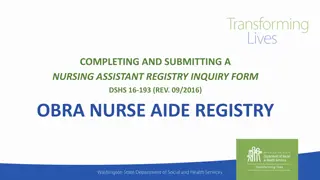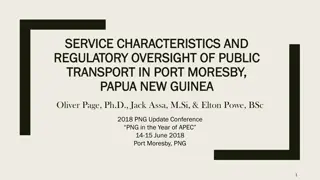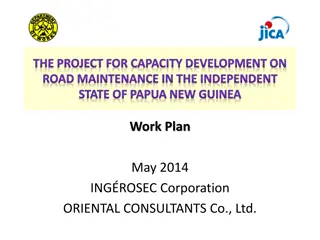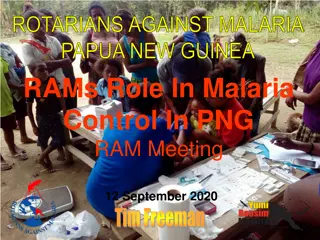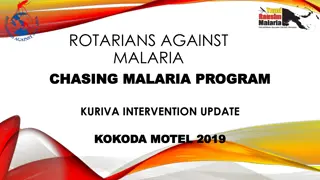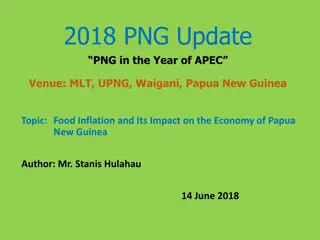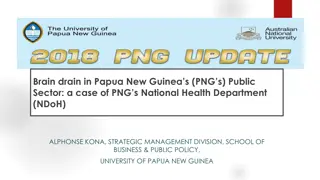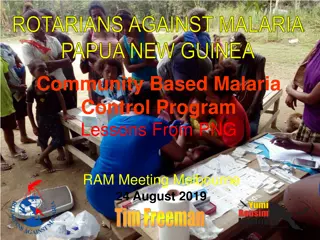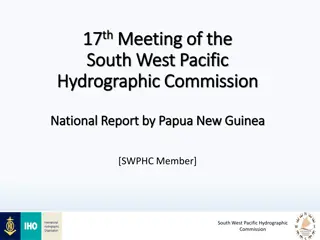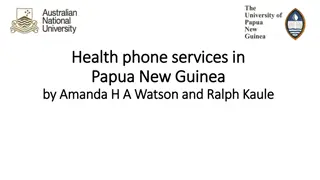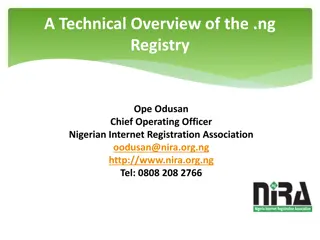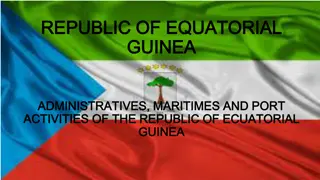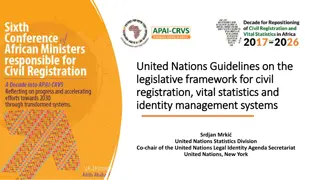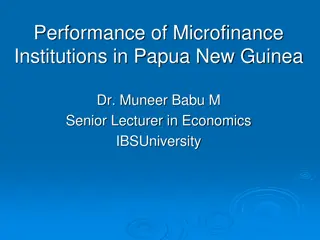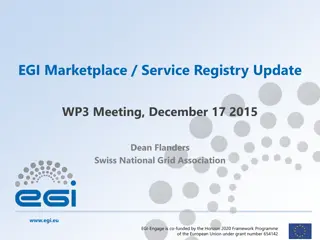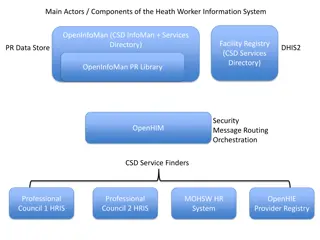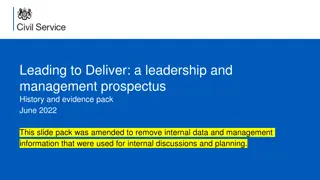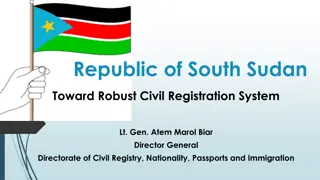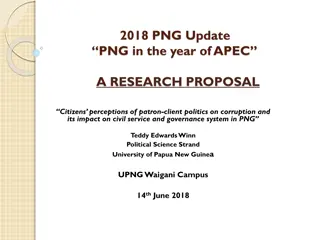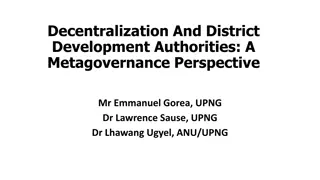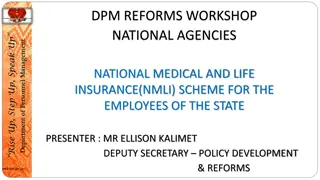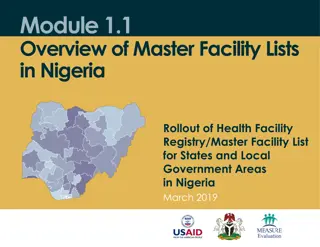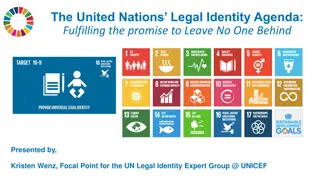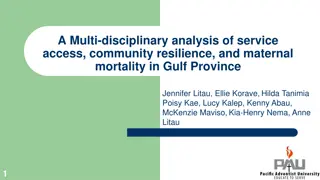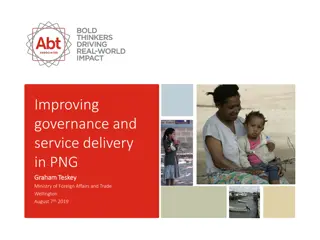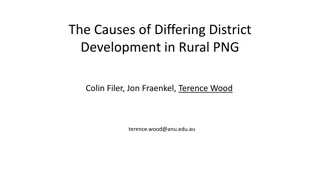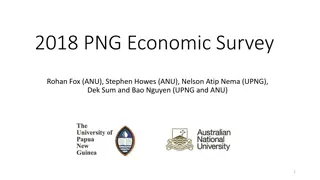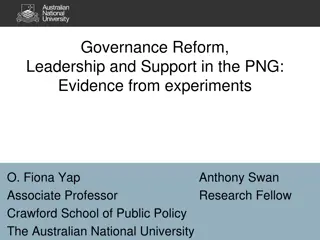Overview of Civil Identity Registry System in Papua New Guinea
The Civil Identity Registry System in Papua New Guinea, established by an Act of Parliament in 1963 and amended in 2014, plays a crucial role in maintaining records for births, marriages, adoptions, divorces, and deaths. The system faces challenges with data sharing due to legislation constraints. The Papua New Guinea National Identity Document Project aims to collect CRVS information, with a new bill in the pipeline for further enhancement. The development history reveals the transition of the registry and the challenges faced in registration and delivery of NID cards. Despite facing operational and technical issues, efforts are being made to expand the system's reach across provinces and districts.
Download Presentation

Please find below an Image/Link to download the presentation.
The content on the website is provided AS IS for your information and personal use only. It may not be sold, licensed, or shared on other websites without obtaining consent from the author. Download presentation by click this link. If you encounter any issues during the download, it is possible that the publisher has removed the file from their server.
E N D
Presentation Transcript
Pacific Regional Workshop on Legal Identity and Identity Security 8-10thJuly 2019 PAPUA NEW GUINEA Noel MOBIHA Registrar General PNG Civil and Identity Registry
1. WHERE WE ARE NOW? (MAY 2019) (MAY 2019)
POP: 8 million +/- Registered: 1,053,396 LAND: 464,000 km2 SEA: around same as land 800 + languages & dialects 1,000 tribes Pop growth rate: 3.5% Many religions People: 1. Melanesians 2. Papuans 3. Negritos 4. Micronesians 5. Polynesians
WHAT IS THE ROLE OF PNGCIR? Established by Act of Parliament. Civil Regstration Act 1963 Ammended 2014. Sharing of data is not happening in country due to existing legislations. Currently the PNG National Identity Document (PNG NID) Project is being used to collect all CRVS information of the population. We estimate the population to be around 8 million in 2018. New Bill with more sectoral inputs is in final stage to go to Parliament this year. Maintains a register for births, marriages, adoptions, divorces and deaths. This includes also running maintaining an Archive. CRVS data is viewd by Government of PNG as foundation data for evidence based planning.
DEVELOPMENT HISTORY Prior to 2014 the registry was parked as a division within the Community Development Department. This changed in 2014. An amendment to the 1963 Act was made. Huawei Technologies designed and installed a customised PNG Civil Identity Registration System (CIRS) in 2012 commissioned in 2015. At the time of registration for persons over 18 years of age enables a person to collect a Birth Certificate and NID card. Persons under 18 get only a birth certificate Progress in registrations of all CRVS data has been slow. A number of operational technical issues have been identified in terms of CIRS system limitations. Vendor Lock in; Software; Integration; and Integration issues.
ROLL OUT SO FAR Provinces connected: 16/22 provinces have fixed offices/mobile operations. Two provincial offices got burnt down. Districts 1. 15/89 Districts connected Developers / Partners: 1. Ok Tedi 2. Total E & P PNG Ltd 3. Pacific Agro 4. Department of Education (Institution)
SPEED OF REGISTRATION AND DELIVERY OF NID CARDS AND BIRTH CERTIFICATES Turn around times are around one month. Urgent cases 3 days. Speed of turn around being addressed. We have implemented a data entry centre to type in registrations and increased approval staffing numbers. All our backlogs from 2015 slowly reduces This reduces the processing time by some 10 working days for an application. Have and will increased call centre staff.
Registered Regions Registered %of Total Southern 520,276 49% 11% Highlands 162,046 15% Southern 25% Highlands 49% Momase Momase New Guinea Islands 258,665 25% NG Islands 15% 112,409 11% 100% TOTAL 1,053,396
HIGH LEVEL SUMMARY MAY 2019 16 PROVINCES CONNECTED 15 DISTRICTS SIGNED MOU 1 MILLION REGISTRATIONS STAFFING OF 400
2. WHERE DO WE WANT TO GO?
Generation II NID Registration Roll Out Plan POPULATION 10,000,000 9,215,714 8,895,477 8,586,368 8,288,000 9,000,000 8,000,000 8,000,000 8,000,000 7,588,000 7,000,000 7,300,000 6,000,000 5,186,368 Rural remote communities Others not done 5,000,000 Mop Up Operations 4,888,000 3,700,000 4,000,000 2,700,000 3,000,000 1,795,477 2,000,000 320,237 1,486,368 700,000 1,795,477 0 1,000,000 0 288,000 320,237 309,109 298,368 0 - Dec July 2021 Dec Dec Dec Dec 320,237 2018 2019 2020 2021 2022 Population Growth To register Registration Balance
LOCK IN ARRANGEMENTS CIRS CORE Interfacing ring
3. HOW DO WE GET THERE?
SUPPORT STRUCTURE PNGCIR will supply a minimum of one mobile registration kit per 20,000 people to do registration in 20 months. Need a young, smart, innovative and willing to work professional team preferably under 30 years of age. Build a supporting infrastructure for the use of NID card. Need corporation from all provinces, districts and development partners. Corporation guided through MOUs for all. Allocated a budget of 2 million cards to deliver in 2019. This means more staff (peaking at 1,300), more mobile registration kits, more floor space, ..... More of everything. Targeting connecting all provinces. Challenge is to make this happen with the current budget of K20.8 million this.
Provinces to fund one kit per District and Districts to fund 2 kits each. Total of 3 kits funded internally. Kits from PNGCIR is additional. Call centre has been established with processes being drawn up to add value to customer enquiries. Facebook is being used to improve customer access. From January-February we had 71.3k viewers. February March (current) we have 65.1k viewers. With above can do one district of 70,000 people in 10 months. Need to run a 24 hour shift for data entry and approval processes. Cost around $US1,500 for 6 months.
Use of the working prototype district model to increase speed of registration. Backend to run 24/7 operations in data entry and approvals. Monitoring performances of all mobile kits. Looking at 1,000 registrations per month for rural and 2,000 per month for towns. Will be trialling printing of NID cards in provinces/ districts. Currently we are only printing birth certificates in the provinces/districts.
TECHNICAL SUPPORT Need to negotiate with existing vendor to interconnect peripheral devices (like printers) etc to the core registration system software. About to finalise a new NID card printer with a new vendor. Use of current stock of NID cards currently undertaken durability test of the existing stock to reduce costs. System upgrade being discussed Serious on knowledge transfer. New design for the new printer for the NID card. Looking into secure ways to automate signing of certificates
Costs of telecommunications will increase. Smart use of VSATs will reduce costs. Use of remote technologies for data upload. Remote sensing data critical for remote villages identification. Increasing specialists numbers in database, software and networking teams More desktops will be purchased.
LEGAL ISSUES Our Bill the Civil and Identity Registration is under its 12th review. It will allow for data sharing options. STEM sector to be involved in discussing regulations. We have written regulations and developed SOP and all supporting the forms including the MCCOD
A RURAL MODEL
CONCLUSION We have a young team with high energy levels. We are pushing for knowledge transfer in all we do and the building of the PNG Knowledge Bank. We are studying existing and working processes of data collection to find ways to improve on. Need to create hunger in registrations and collection of CRVS data. Trialling NID card printing in Districts. Political support has been good. We need more funding support. To development partners, with you assisting the NID Project you are serving the whole country not just a district or a province. Targeting December 2021 to complete the nationwide registration Challenges are many but we believe with God s Speed and Blessings it is doable.
WE ACKNOWLEDGE OUR SPONSORS Bloomberg D4HI (Global Health Advocacy Incubator, Vital Strategies, Melbourne Uni); UN Systems (UNDP, UNFPA and UNICEF); DFAT (Govt of Australia); and National Planning and Monitoring Department (GoPNG)


